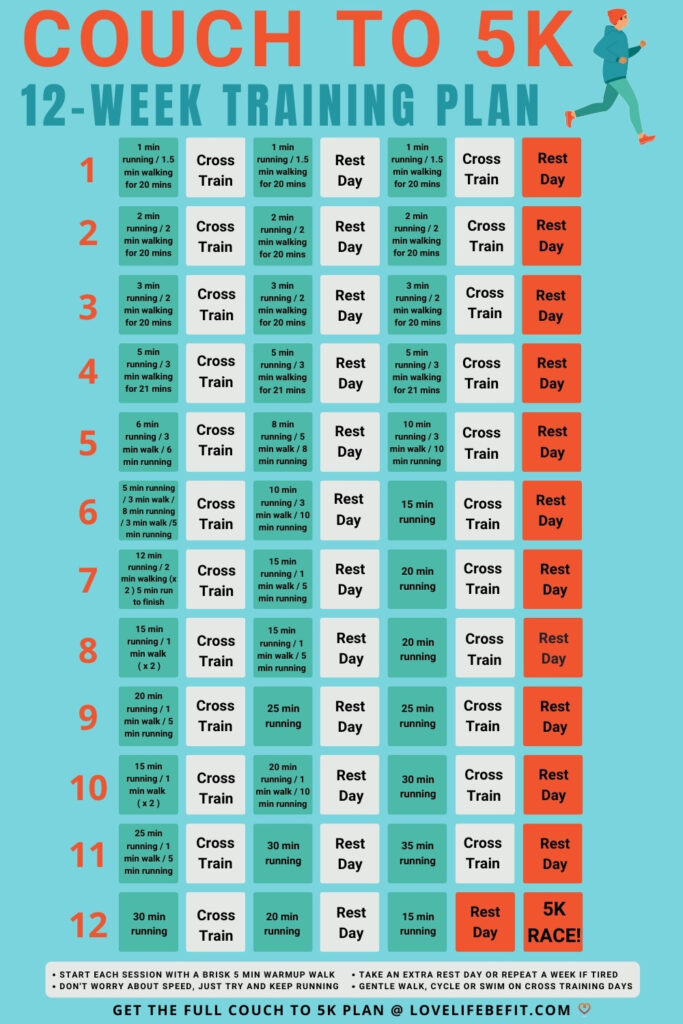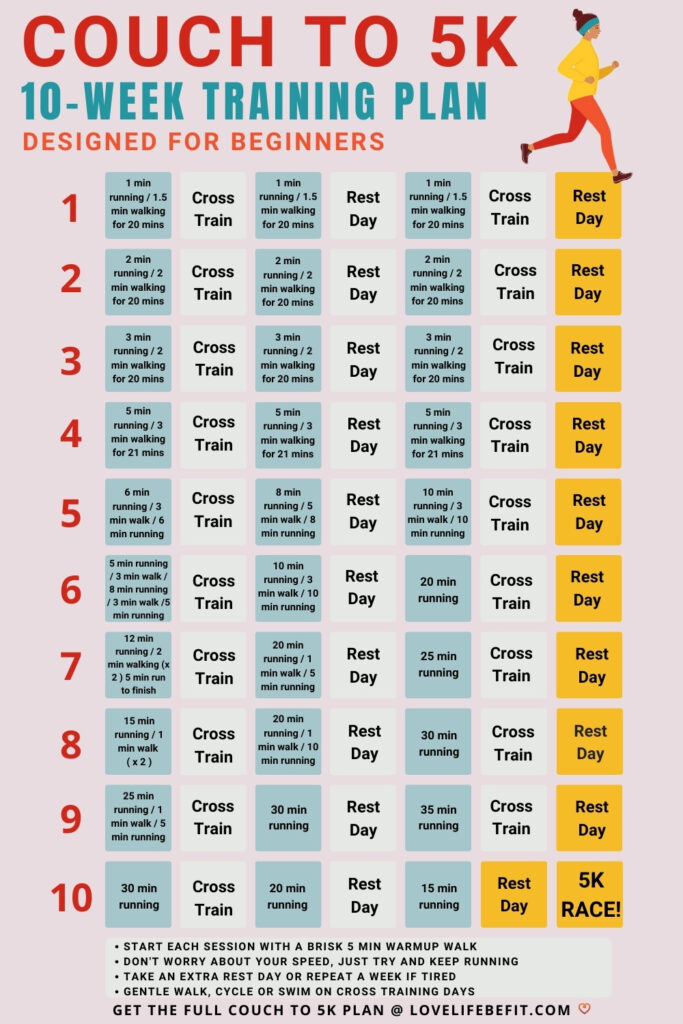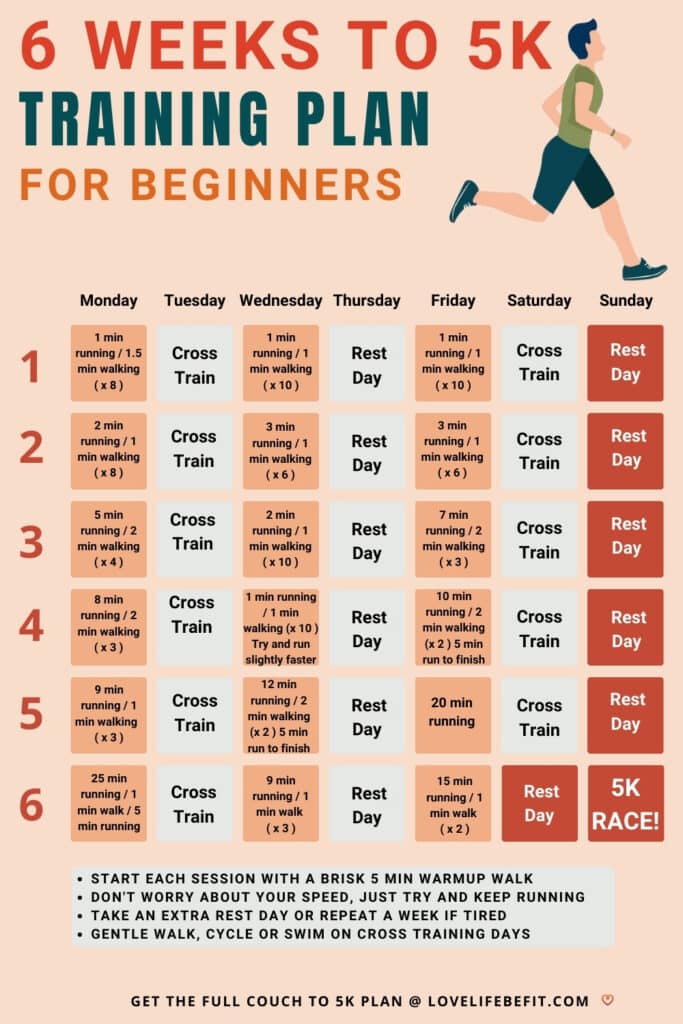How To Train For A 5K For Beginners + 5K Training Plan
This guide will show you how to train for a 5K when you’re a complete beginner and make the training as easy as possible. It’s a guide for new runners with no experience who want to start running but are worried about being out of breath and struggling after the first few yards.
Training for a 5K makes an excellent running goal for beginner runners. The aim of this plan is to build up to running the 5K (3.1 mile) distance without stopping. A regular running program will help you feel fitter and stronger within a few weeks, even if you’ve never run before.

Why Run A 5K?
A 5K is a good target for beginners. It’s not too far in running distance and most new runners can train for a 5K in 2 to 3 months.
Running is an excellent way to invest in your health. It’s good cardio and can help you live longer. You’ll see your fitness improve and at the end of your 5K training, you’ll be running regularly.
How Far Is A 5K?
5K in miles is 3.1 miles. The “K” stands for the metric unit kilometers. 5K represents 5000 meters. It’s the most popular running race distance in the US.

How The Run/Walk Method Makes Training Easy
Starting a training program can be daunting. Maybe this is your memory of the last time you tried to run:
- Lungs bursting.
- Struggling to catch your breath.
- Your legs feel like lead…
This is typical of how most runners feel when they begin training. But we don’t want to put you off before you even start running!
Running doesn’t have to be this hard. Our training plans use the run/walk method for complete beginners to make running feel easier.
Unlike typical 5K training plans where you launch straight into non-stop running for 5 minutes+, our Couch To 5K plans use interval training. You’ll run for just one minute before taking a walking break.
The walking breaks at a brisk pace let you catch your breath but you’re still working your body and improving your fitness. Your joints and muscles benefit from the brief rest from running.
By alternating running and walking you’ll be able to keep going for longer and the time spent walking helps to improve your overall fitness. You’ll get more out of your training sessions.
As you get fitter the running intervals gradually increase and the walking intervals get shorter until you’re running consistently. This approach to running is as pain-free as it gets!

Why You Need A 5K Training Plan
Of course, you could just go running. Lace up your running shoes, head out the door, and see how far you get!
But it’s so easy to get carried away. Put too much effort into the first few days of training and wake up mid-week feeling so stiff that you’re barely able to get out of bed.
It happens so often and the result is a demoralized new runner.
With a training plan, you’ll avoid doing too much too soon. The training sessions start at an easy level and gradually get harder. Following a training plan keeps you focused and incentivized, progressing at a level your body can cope with.
Choosing The Right 5K Training Plan
There’s no one-size-fits-all training plan for 5K runners. Even beginner runners have different levels of fitness.
Some new runners will have residual fitness from other sports and activities, some will start with a good level of walking fitness and others will be so unfit they can’t remember the last time they exercised (if this is you don’t worry – we still have a training plan for you).
We have six different 5K training plans for beginners plus a 5K walking plan and a 5K treadmill plan.
Be honest about your current fitness and choose from the following plans. It’s better to take longer to reach the starting line of your 5K race than try to progress too quickly.
5K Training Plans
Couch To 5K 12-Weeks
A plan for complete beginners with very little running experience. If you can walk for 20 minutes at a brisk pace, you’re fit enough to complete the first training session.
The weekly schedule includes 3 running workouts, 2 cross-training days, and 2 rest days.
Couch To 5K 10-Weeks
Progress is a little faster than the 12-week plan but there’s still plenty of time to adapt to running.
This weekly schedule for complete beginners includes 3 running workouts, 2 cross-training days, and 2 rest days.
Couch To 5K 8 Weeks
This is still a plan for complete beginners but it helps if you have some fitness from other sports.
The weekly schedule includes 3 running workouts, 2 cross-training days, and 2 rest days.
Couch To 5K 6 Weeks
If you’re a beginner runner, this 6-week plan will be challenging but possible. It will help to have some fitness from other sports.
The weekly schedule includes 3 running workouts, 2 cross-training days, and 2 rest days.
Couch To 5K 4 Weeks
This 4-week schedule is for occasional runners or people with some fitness from other sports. It’s also a good plan to use if you’re returning from injury.
The weekly schedule includes 4 running workouts, 1 cross-training day, and 2 rest days.
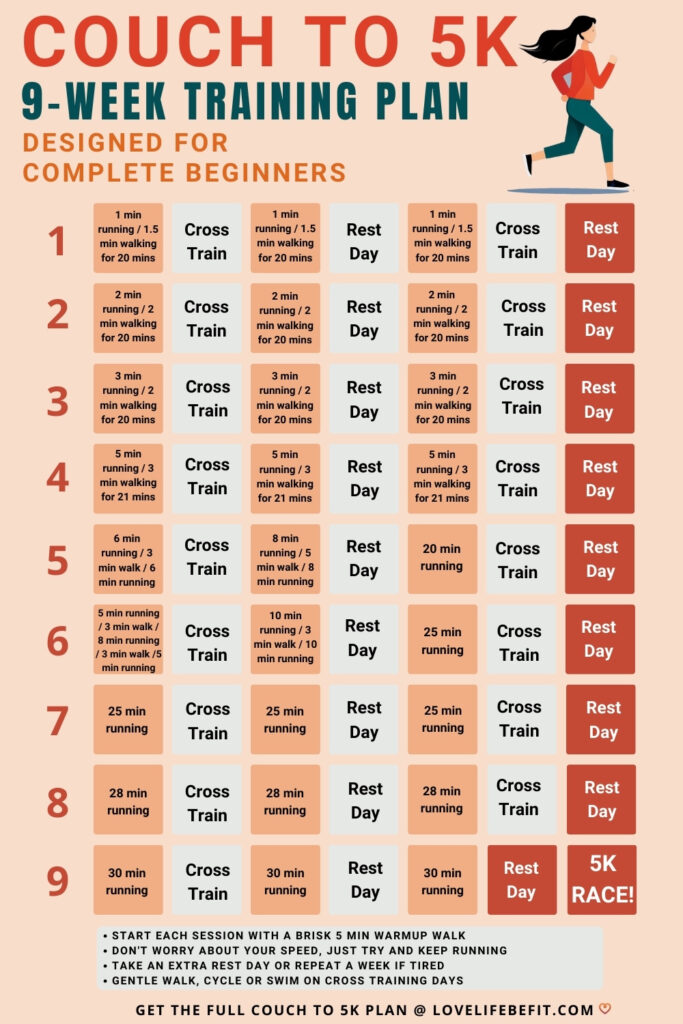
Couch To 5K 9 Weeks
The original Couch To 5K program with just a few adjustments.
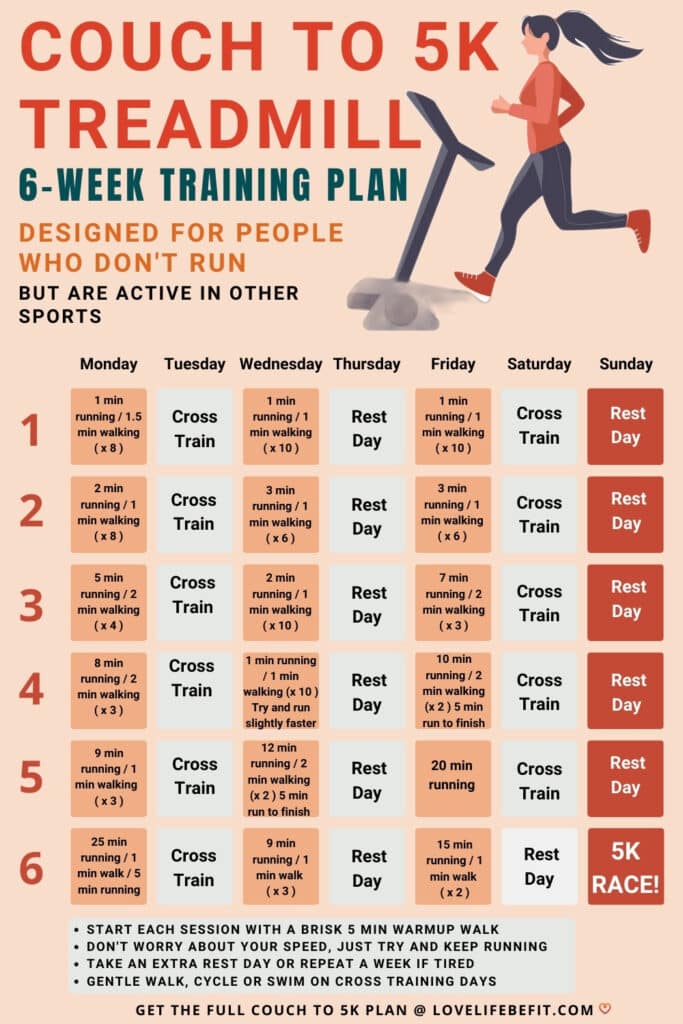
Couch To 5K Treadmill
A complete guide to Couch To 5K on a treadmill with 6-Week and 9-Week Couch To 5K Plans
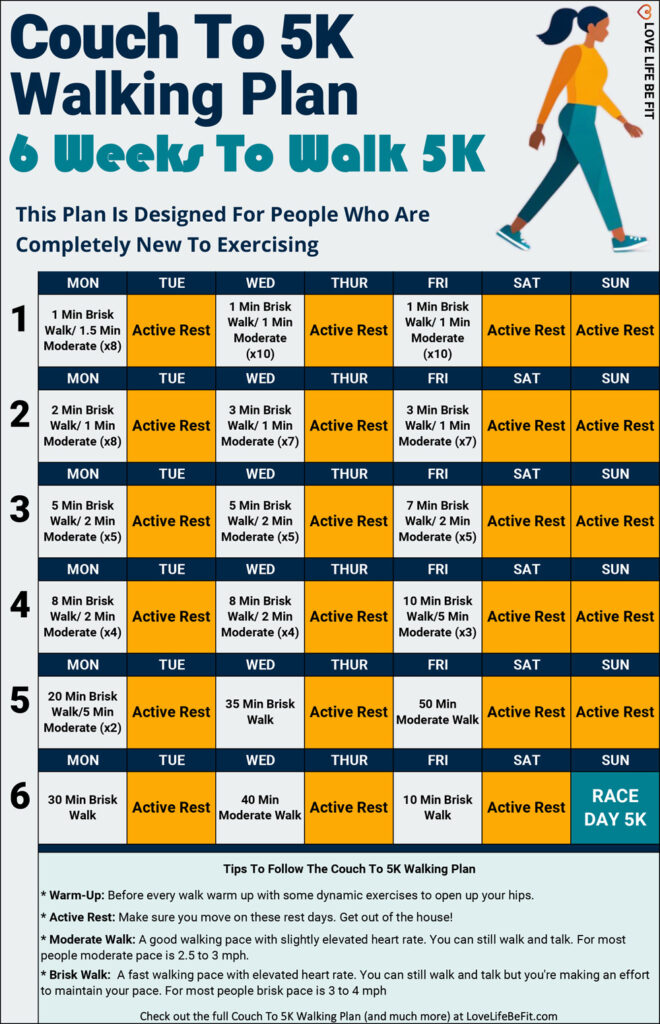
Couch To 5K Walking Plan
Our Couch To 5K Walking Plan is a good way to improve your fitness. Follow our walking plan before advancing to a Couch To 5K Running Plan.
How To Train For A 5K In 7 Steps
Follow these 7 steps to train for a 5K and you’ll be raring to go when you line up for your 5K race:
- Download a 5K training plan that matches your current fitness level.
- Enter a 5K race.
- Use the run/walk method to start running continuously.
- Add cross-training days to your training regimen.
- Start strength training.
- Improve your diet.
- Monitor your progress.
#1 Download a 5K Training Plan
Start your training by downloading a 5K plan. Our plans range from 4 weeks to 12 weeks and if you’re starting from a very low fitness level and carrying a lot of excess weight, it can be best to start with a 5K walking plan.
#2 Enter a 5K Race
It’s much easier to stick to a training schedule if you have a target to aim for. Entering your first race will give you a target and help to keep you motivated.
Find a local fun run or parkrun, a race that won’t be too intimidating with lots of other beginner runners. Encourage some friends to enter the race with you and become your training buddies!
#3 The Run/Walk Method
This is your secret tool for running continuously. It works! Just make sure you don’t run too fast during the run sessions.
You should be running at a conversational pace. It will be hard at first to get your breath but as the weeks progress you should be able to talk and run at the same time.
Try and run at an easy pace and if the running feels hard – slow down!
#4 Add Cross-Training
Cross-training is when you take part in sports and activities that complement your running. You’re giving your running muscles a rest and helping to avoid muscle imbalances. Find out more about cross-training for runners.
Cross-train by swimming, cycling, or any activity you enjoy. Most of our 5K training plans include at least one 30-minute cross-train session a week.
#5 Strength Training
The high impact of running can be a big shock to your system when you’re a beginner runner. You need to strengthen your legs and core!
Most of your 5K training plans advise strength training at least once a week. They don’t need to be long sessions and lifting weights isn’t essential. These bodyweight exercises for runners are ideal.
#6 Your Diet
You’re now a runner and what you eat is fuel for your body. If you’ve started running to lose weight, be patient. Weight loss takes time.
Your diet is just as important as exercise when it comes to weight loss. Fill up on the good stuff – whole grains, vegetables, lean protein, some fruit, and small amounts of healthy fats.
#7 Monitor Your Progress
Don’t feel constrained by your training program. If you’ve chosen to train for a 5K in just six weeks and you’re struggling to complete the sessions, you can always switch to a different training plan.
It’s better to take longer to get to race day, or walk and run your way to the finish line, than risk getting injured by doing too much too soon.
Rest days are extremely important when you’re training. If you wake up feeling sore after a running session – take an extra rest day!

Thoughts From Love Life Be Fit
These are just a few tips for beginners that will help you get to the start line of your first 5K race. You’ll find more information on this site to help you start training from how to breathe while running to running form for beginners and what to wear.
When you complete your first race – don’t forget to celebrate, then pick your next running goal!
It could be running further, such as a 10K or half marathon, or trying to improve your 5K time with our Intermediate 5K Training Plan.
Running 101 Training Guides & Walking Schedules
5K Training Plans
- Couch To 5K Beginner Training Plan
- 12 Week 5K Training Plan
- 10 Week 5K Training Plan
- 8 Week 5K Training Plan
- 6 Week 5K Training Plan
- 4 Week 5K Training Plan
- 5K Training Plan Intermediate


